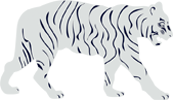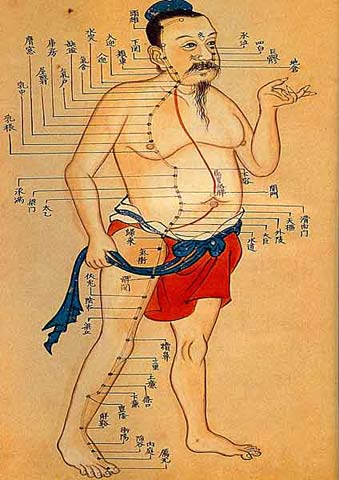The most important focus of the Feng Shui Form-School is the analysis of the surrounding landscape. This landscape can be literally the surrounding nature as well as a city-surrounding.
Within this the analysis of the Four Animals - Si Li - is used.
The Four Animals (4 Animals) are:
- the Dragon
- the Fèng Huáng (often translated as Phoenix)
- the Tiger
- and the Turtle
(some Feng Shui schools also mention the Snake (Five Animals / 5 Animals).
The landscape forms are arranged to the following animals as follows:
the Dragon
The Dragon sits on the east side (left) and acts inspirational and creatively.
the Fèng Huáng (Phoenix)
The Fèng Huáng is in the South (front) and is energetically strong and dynamic.
the Tiger
The tiger is in the west (right) and shows physical strength and is collecting energy.
the Turtle
The turtle is in the north (back) and gives the structure stability, security and reliability.
The directional assignment is based on the Chinese weather-axis. In China this is a clear North-South direction. If the Form School is being used in Germany, depending on the landscape surrounding, the direction might be adjusted to the German weather-axis which is North-East to South-West (for example in Berlin).
The four animals are symbolic and their correlation is to the landscape images like mountains, valleys and rivers. However in the city these correlations would be adjusted to buildings, gardens and streets. Even within an apartment or flat they can be used to determine the directions and functions of walls, tables/furniture and windows.
Assembly of the Four Animals (Si Ling):
The assembly of the four animals is always in the same order. The alignment is adjusted according to the view. In classical China the best-possible view was to the South - towards the sun and warmth. This is where the classical assignment towards the North-South direction: the turtle in the North and backside of the house, the dragon to the left, the tiger to the right and the view infront resembles the Fèng Huáng (Phönix).

{jshop-prod-ins:3}
The mythology of the Four Animals:
The Dragon

The dragon (chin. Long 龍) is used as one of the main four animals in the Feng Shui Form school and is known as a Fu (lucky charm - lucky dragon). According to legend the mythology of the dragon goes back at least 4 thousand years BC.
In China as well as in the Asian countries the dragon is the highest spiritual being. It stands for wisdom, strength and energy. Unlike our culture, where the dragon is shown as a fiery fire-spitting monster, the dragon is a good-willed and wise animal in China. It is able to move elegantly and can achieve great things, think sharply and is able to take on large projects and successfully fulfill them.
The dragon stands for a female animal with strong Yang character, which is why it is representing Yang energy.
In the landscape dragons can be found in the mountain- and hill-chains. Should there not be a natural landscape representing the dragon, then it can be adjusted by planting vegetation which ideally should be higher than the tiger.
The dragon represents the element Wood within the five element philosophy and hence represents the color green.
Der Fèng Huáng (Phoenix)
 The Fèng Huáng or also called red phoenix is also an integral part of the four animals of Feng Shui Form School.
The Fèng Huáng or also called red phoenix is also an integral part of the four animals of Feng Shui Form School.
It stands symbolically for the front-side of the house or estate.
The chinese Phoenix does not resemble what we know as the European phoenix. The first time the Fèng Huáng was mentioned in China was ca. two thousand years BC. According to legend the Fèng Huáng then was the God of Wind, which explains the Chinese character "feng" (wind) within its name.
Described and depicted is the phoenix as a magical bird full of elegance and beauty. Within his feathers it combines the jewellery of peacock and pheasant as well as the holy colors green, white, red, black and yellow.
The presence of a Fèng Huáng always stood the presence of a good king. Together with the dragon it is the symbol for the Emperor. Often the phoenix on its own represents the Empress while the dragon on its own represents the Emperor.
What's more the phoenix is also used in a sexual coherence. "The two phoenix pierce the blossom" is a description for marital sexual intercourse while "false male and empty female phoenix" stands for homosexuality.
The Tiger
 Within Chinese Mythology the tiger is calm and reserved. The tiger is a Yang animal with strong Yin attributes, which is why it resembles Yin energy.
Within Chinese Mythology the tiger is calm and reserved. The tiger is a Yang animal with strong Yin attributes, which is why it resembles Yin energy.
The tiger is the guardian of the western paradise, which is the home of all Chinese gods, and disperses all vicious spirits.
Within the landscape form the tiger should be a little smaller than its opposite the dragon. If both are the same size it can lead to a stagnation of Chi. If the tiger is dominant (larger) then it might lead to a shortage of Yang energy.
Soft elevations of mountains and foothills are the ideal landscape form to represent the tiger. As most of us however do not live in such a natural landscape, we need to represent these patterns through neighboring buildings. Again should there not be a natural landscape in this form, these can be created by for example planting trees and vegetation.
The tiger represents the element Metal within the five elements philosophy and hence represents the color white.
The turtle
 The turtle is the animal with the highest meaning in Asian countries. The animal stands for longevity, long life, consistency, strength, durability and wisdom.
The turtle is the animal with the highest meaning in Asian countries. The animal stands for longevity, long life, consistency, strength, durability and wisdom.
Within Feng Shui the turtle is the solid back protection a building or a person within a house should have. This can be a protective mountain, a forest, a wall or other building structure.
The symbolic meaning of the turtle in figurines and pictures is still used in China, however it cannot replace a structural construction.
{jshop-prod-ins:3}



 What is Chinese medicine?
What is Chinese medicine?